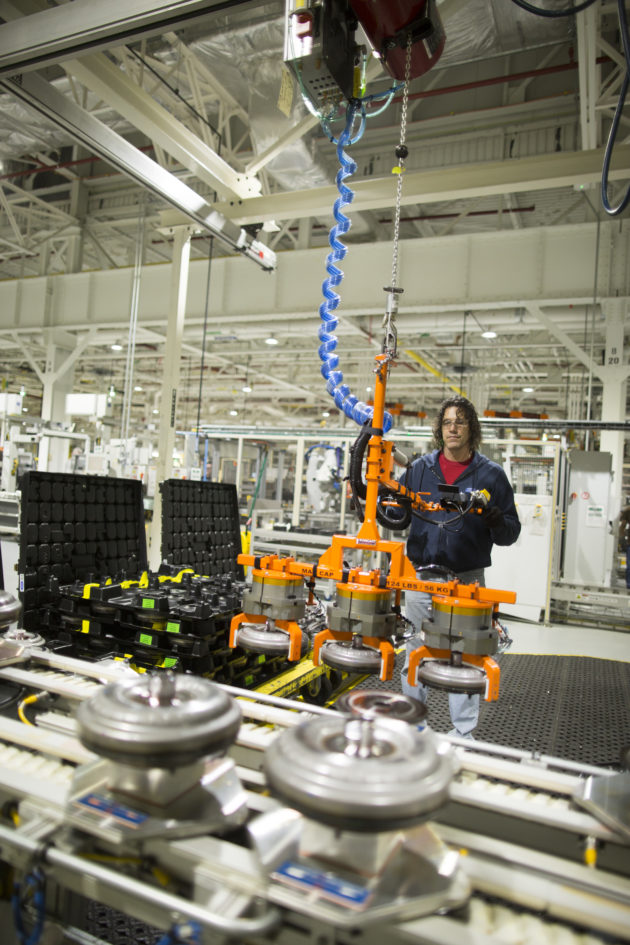There are few things I find as exciting as exploring revitalizing manufacturing or production facility. When people and technology come together to make useful products in a clean and safe manner is art to me.
Therefore, I was happy that my Siemens contacts talked me into driving up to Detroit earlier than I planned to tour the Ford Livonia Transmission plant on March 19. I planned to come up for the noon tour at FlexNGate, but the changed plans worked wonderfully.
Ford Powertrain was a customer of mine in the 80s when I worked for a company that designed and built automated machines and then through the 90s when I was a sales engineer solving problems and selling automation and electrical equipment. So, I witnessed the beginnings of the evolution of these manufacturing plants from dark, dirty, smelly, oily, dangerous, loud environments to today’s clean, efficient, professional facilities.

Mike Bastian, Advanced Engineering Manager Ford Powertrain, explained Ford’s journey from 2000 to present to increase use of digital in manufacturing—The Digital Manufacturing Strategy. He told me that since beginning the present system journey in 2008, they were doing IIoT before there was an IIoT.

Bob Groden, plant manager, described the journey that began with removing several obsolete lines, gutting the facility, painting and cleaning, and preparing for additional transmission assembly lines. This plant is huge. And he walks it three times a day greeting people and asking how things are going. As he told me, “I get my steps in.”
The three themes include people working together, safety, and quality. An important note: The plant continuously added people over the rebuild time all the while increasing automation. three themes; added people continuously all the while automating the plant. Groden and UAW Local President Keith Miller talk to every new employee class and then follow up with each later on the line.
Jon Guske, manufacturing engineering manager-feasibility, described a system the team built beyond the computer-aided engineering system—discrete event throughput simulation. It can connect to VR to help OEMs understand the process and product before beginning machine design. It even models chip removal in machining processes to improve manufacturing process.
- Following are pieces of the Digital Manufacturing Strategy as bullet points:
- Standard Hardware Architecture
- IP65–removed all the large enclosures in the plant (aside, using Siemens because it could do it; one company went to management and flat out told them that Bastian was wrong, management said don’t ever say he’s wrong; another company gets to the spec via a work-around he didn’t like)
- Common PLC/CNC
- Common configuration and programming software
- Integrated safety
- Virtual commissioning
- Obsolescence management (upgrade path)
Network Standard
Ethernet, specifically Profinet—called Control Production Network
- Software Standard—Ford Automation Software Template
- Standard function blocks
- Standard HMI Screens
- Standard linkages
- OEMs are trained and must adhere
- Lean Manufacturing Assistant
- Process Configuration Management System
- Condition Monitoring
- Part Tracking System, extensive use of RFID
I had an opportunity during the tour to talk with Scott King, IT Lead, Advanced Manufacturing Powertrain, Solutions Development. I asked about the mythic IT/OT split and convergence. He basically said, “What split?” He sits with engineering advanced manufacturing lead and they discuss projects and problems daily. Plant projects teams include these roles—IT Solutions, Engineering, Product Lead, Operations. They’ve been working together for six years.
FlexNGate
FlexNGate is a Tier One supplier of stamped metal and injection molded plastic parts. The company has $6.5 B sales, 70 plants, and presence in many countries. It just built a 454,000 sq. ft. plant in burned-out Detroit neighborhood manufacturing parts for Ford Ranger. It is the largest investment in the city of Detroit in 20 years.
There were a couple of determining factors in the plant location. Ford wanted supplier to be local. The city wanted plants to locate in distressed areas that would also hire locally to provide jobs and hope to the area. They pledged 250 jobs, have 350 full time and 250 temporary and the plant is just a year old and still stabilizing processes after the significant production ramp up.
They run the new hires through training from such things as showing up on time every day, following work instructions, safety, and quality.
Two impressive facilities in one day. That’s a pretty good day.




